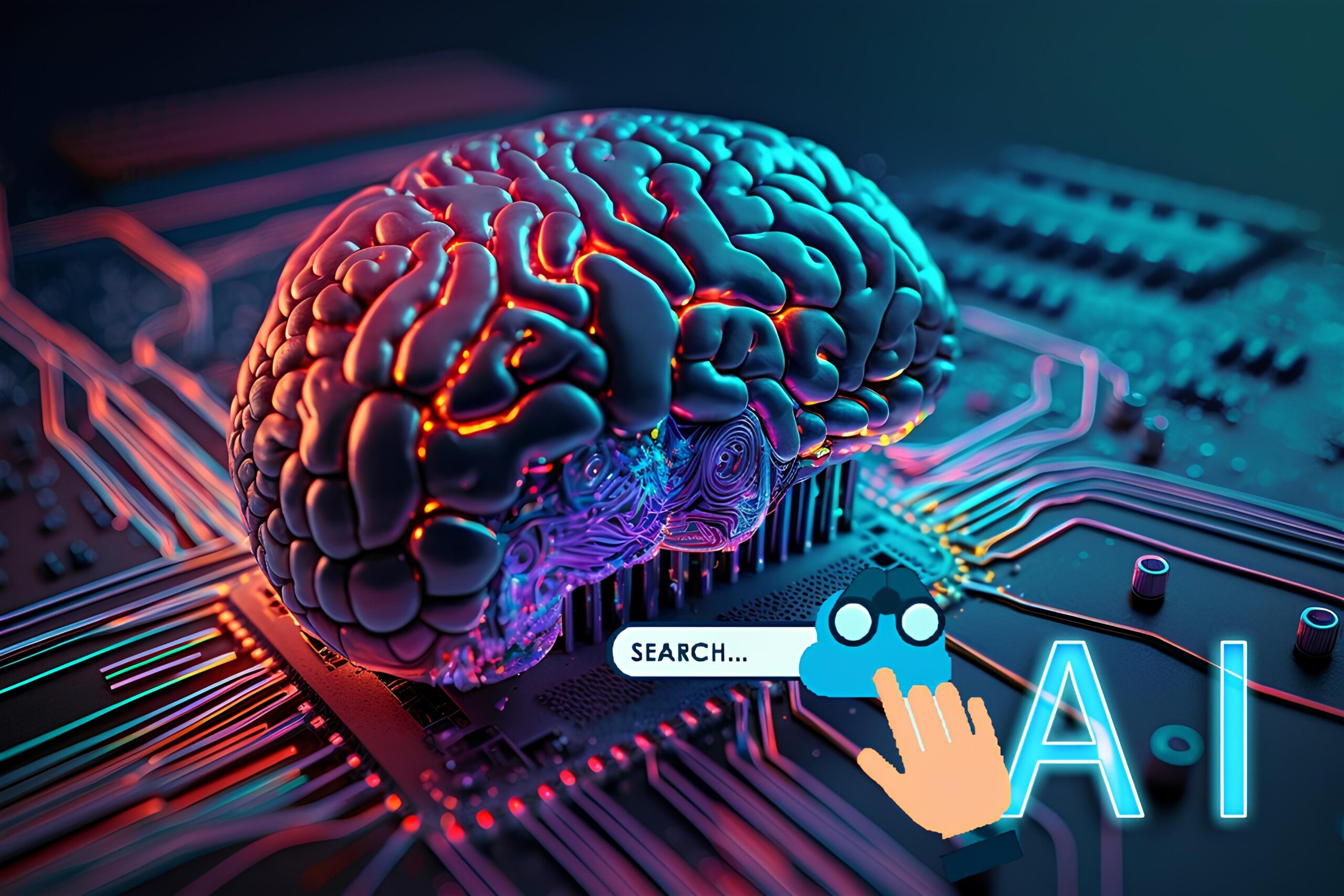The Comprehensive Impact of Artificial Intelligence on User Information Seeking Behavior

Artificial Intelligence (AI) has profoundly reshaped user information seeking behavior, transforming it from traditional keyword-based queries to natural, conversational, and multimodal interactions. The integration of foundational AI technologies such as Natural Language Processing (NLP), Machine Learning (ML), Deep Learning (DL), Large Language Models (LLMs), and multimodal AI has enabled search engines like Google and Bing to provide direct answers, content summaries, and unprecedented personalization of results. This delivers higher efficiency and relevance for users. However, this transformation also comes with significant challenges regarding information accuracy, algorithmic bias, data privacy, and the impact on the online content ecosystem. The future of search is predicted to continue evolving towards proactive AI agents and hyper-personalized experiences, demanding responsible development and adaptation from all stakeholders.
1. Introduction: The New Era of Information Search with AI
Historically, search engines primarily operated based on keyword matching and content indexing. However, the advent of artificial intelligence (AI), particularly advancements in machine learning (ML), deep learning (DL), and natural language processing (NLP), has fundamentally changed this paradigm. AI is now a key driver in digital marketing and information retrieval, enabling leading search engines like Google and Bing to enhance the accuracy and relevance of results.
The integration of AI into search has been gradual but is accelerating significantly, moving from basic algorithmic improvements to sophisticated conversational AI. Sundar Pichai, Google’s CEO, has long championed generative AI and pushed for its integration into core search services. The emergence of powerful AI chatbot tools like ChatGPT, Grok, and DeepSeek has created significant competitive pressure, prompting Google to accelerate its AI integration efforts to maintain user engagement. This competition not only drives technological progress but also reflects the urgent need for major tech companies to retain users who are seeking more direct and conversational answers. This indicates that the rapid pace of AI integration into search is not solely due to technological advancement but is also significantly influenced by market pressure and the need to retain users.
This report aims to analyze the multifaceted impact of AI on user information seeking behavior, specifically how AI has changed user interaction methods, the nature of search results, the efficiency and accuracy of information retrieval, as well as associated challenges. The report will cover leading search platforms such as Google and Bing, and explore future trends.
2. Foundational AI Technologies Transforming Search
The transformation in information search is driven by a range of advanced AI technologies, each contributing to the ability to understand and respond to user queries more intelligently.
2.1. Natural Language Processing (NLP) and Models (BERT, MUM)
Natural Language Processing (NLP) is a field concerned with the interaction between computers and human natural language, aiming to enable computers to “understand” the content of documents, including the contextual nuances of the language within them. NLP is fundamental to modern search, facilitating semantic keyword analysis, contextual content optimization, sentiment analysis, and voice search optimization. It helps improve the understanding and contextual optimization of content, thereby enhancing SEO effectiveness.
Google introduced BERT (Bidirectional Encoder Representations from Transformers) in late 2019. This is an NLP technique based on machine learning and neural networks, designed to significantly improve Google’s ability to understand the meaning of search queries by considering the context of words from both sides. This marked a major step forward, helping Google Search better understand the true intent behind user queries, rather than merely mechanically matching keywords as before. Instead of reading each word in isolation, BERT understands the relationships between words in a sentence, including preceding and succeeding words, helping Google rank results based on their relevance to user needs. This shift indicates a profound change in search engine philosophy from a lexical approach (word matching) to a semantic approach (understanding meaning and intent). For users, this means more relevant results even for vaguely worded or conversational queries. For content creators, this requires focusing on natural language, comprehensive content, and user intent rather than just keyword stuffing.
Google MUM (Multitask Unified Model) is an advanced unified multitask model, designed to search the internet across different languages and through images to find answers to complex questions that do not have direct answers. MUM’s goal is to reduce the average number of search queries (currently 8 times) needed to resolve complex questions by anticipating user needs. MUM understands 75 different languages and can synthesize information from various content formats, including images, videos, and podcasts, providing a comprehensive search experience. MUM’s ability to understand and provide solutions not only based on text content but also interpreting images, videos, and podcasts in an unprecedented way indicates a significant expansion in search comprehension capabilities. This implies that search is no longer limited to text. Users can expect to search and receive results in various formats (text, image, voice, video), leading to a richer, more intuitive, and comprehensive information retrieval experience.
2.2. Machine Learning and Deep Learning in Personalization and Ranking
Machine Learning (ML) is a branch of Artificial Intelligence (AI) that enables computer systems to learn and improve from data without explicit programming. In search, ML algorithms analyze historical data and user behavior to predict preferences, optimize SEO strategies, and improve result relevance. RankBrain, a Google ML algorithm, is a prime example, helping to understand complex and novel search queries by learning from user interactions and how they engage with search results .
Deep Learning (DL) is a subset of Machine Learning that uses artificial neural networks with multiple layers to analyze and learn from large, complex datasets. Unlike traditional ML, DL has the ability to automatically extract features and patterns from data, leading to higher accuracy in tasks such as prediction and classification. DL algorithms are crucial for understanding context in search queries and personalizing results, as seen in Bing AI’s use of deep learning to analyze and understand the context of search queries. ML and DL have transformed search from a passive information retrieval system into a more proactive and predictive one. By continuously learning from user behavior and vast datasets, these technologies enable search engines to anticipate user needs, personalize results with increasing accuracy, and even suggest new queries or content, making the search experience significantly more intuitive and relevant.
2.3. Large Language Models (LLMs) and Generative AI
Large Language Models (LLMs) are massive AI models capable of processing billions of parameters, used for generative AI to create content based on human language prompts. They serve as the foundational mechanism between users and AI models, allowing the system to understand user prompts and provide relevant content.
Generative AI is a key application of LLMs, enabling the creation of new content such as text, images, and videos. Google’s “AI Mode” and “AI Overviews” are examples of generative AI that provide direct answers and summaries, changing the search results page. Bing AI also supports generative capabilities, including creating vivid content and images. This represents a paradigm shift from search engines merely indexing and retrieving existing web pages to actively generating and synthesizing information to directly answer user queries. This fundamentally changes user interaction from browsing a list of links to receiving a direct, curated response, potentially reducing the need to click on external websites.
2.4. Multimodal AI
Multimodal AI refers to AI models capable of processing and integrating information from multiple modalities simultaneously, such as text, images, audio, and video. This allows AI to understand and interact with the world more comprehensively, similar to human perception. In search, this enables search engines to understand queries and provide results that combine different types of data. Examples include image annotation (generating natural language descriptions for visual data), visual question answering (VQA) (answering natural language questions based on image content), and image-text retrieval (matching text queries with relevant images). Google’s AI Mode allows users to ask questions using text, voice, or images, demonstrating multimodal interaction. The integration of multimodal AI represents a step towards making search more aligned with how humans naturally perceive and interact with the world. Users are no longer limited to typing keywords; they can speak, show images, or even combine these modalities. This makes search more accessible, intuitive, and efficient, especially for complex or visual queries.
3. How AI Has Changed How Users Interact and Ask Questions
AI has significantly changed how users interact with search engines, moving from simple queries to more complex and natural interactions.
3.1. Shift from Keywords to Natural Language and Conversation
Instead of traditional keyword-based searches, users can now interact with search engines as if conversing with an expert. Google’s “AI Mode” allows users to ask questions and receive answers from AI, and continue the conversation with follow-up questions, exploring topics in more detail. This feature is currently in Search Labs and available in English for users aged 18 and above in selected regions. Bing AI also offers a chat feature, allowing users to engage in conversational interactions to receive answers and support in various situations, providing a more natural and flexible interactive experience. This conversational capability is a direct response to the rise of chatbots like ChatGPT, which has led to a decline in traditional Google users.
AI has significantly boosted voice search capabilities. Users can now use their voice to search on Google, asking questions like “Directions to Co. opmart” or “Where is the nearest coffee shop?”. Voice search is significantly faster than typing (an average of 150 words per minute compared to 30 words per minute when typing) and more convenient, helping to avoid repetitive strain injuries. It supports over 300 languages and various dialects.
AI also allows users to search by image, by uploading existing photos or taking new ones. Google Lens enables users to learn more about objects around them by simply pointing their camera, facilitating visual search for information or similar images. AI Lens Finder and similar tools allow users to find related images online by uploading a picture, providing intelligent reverse image search capabilities. The shift from keywords to natural language and the introduction of voice and image search have democratized information retrieval. Traditional keyword search often required users to think like a machine, breaking down their queries into specific terms. Natural language processing allows users to ask questions as they would ask another person. Voice search is noted as faster and more convenient, even helping to avoid typing-related injuries. Image search enables queries based on visual input, which can be more intuitive for certain types of information. This trend makes information retrieval more accessible to a wider range of users, including those less tech-savvy, those with physical limitations, or those in environments where typing is inconvenient.
3.2. Changes in the Format and Type of Results Received
AI-powered search now often provides synthesized and summarized answers directly, known as “AI Overviews” (Google) or “AI Mode” (Google) and “AI Chat” (Bing). This means users can receive comprehensive answers instantly without clicking on multiple links. Google’s Search Generative Experience (SGE), currently in its experimental phase, aims to address complex queries that previously required multiple searches (an average of 8 searches) by providing AI-generated answers directly on the Search Engine Results Page (SERP) . These AI-generated answers are often presented with links to original sources for verification and further exploration, allowing users to delve deeper into the topic.
AI analyzes past user data, including search history, browsing behavior, purchase history, social media interactions, location, and demographic information, to personalize search results and content recommendations . This comprehensive data collection allows AI to understand each individual’s identity, behavior, needs, and preferences . This personalization extends to product recommendations, promotions, and even user interface adjustments, aiming to increase user satisfaction and conversion rates by providing highly relevant offers. Google’s “AI Mode” increasingly provides personalized query suggestions based on user search history, helping users leverage the full potential of the software.
While personalization enhances user experience by providing highly relevant results, it also raises significant concerns about data privacy and the potential for filter bubbles or echo chambers . The more AI learns about users, the more tailored (and potentially limited) their information exposure becomes. This creates a tension between convenience and breadth of information, as well as ethical considerations surrounding data collection and user control.
AI also enhances the presentation of search results by integrating various media types such as images, charts, and tables, making information more visual and easier to conceptualize and compare. For example, Google MUM will place special emphasis on video marketing, scrutinizing video content to extract timestamps and personalize video suggestions, providing direct video results and closely related video links .
4. Impact of AI on Search Efficiency and Accuracy
AI has profoundly impacted both the efficiency and accuracy of information search, though it also comes with its own set of challenges.
4.1. Improved User Intent Understanding and Relevance
AI, especially NLP models like BERT and MUM, enables search engines to go beyond simple keyword matching to deeply understand the nuances, context, and true intent of user queries, even for complex or novel phrases . This enhanced understanding leads to significantly more relevant search results, improving the overall user experience by providing accurate and useful information .
4.2. Enhanced Information Retrieval Efficiency
AI-powered search engines can process vast amounts of data quickly, providing faster results than traditional search engines. Features like “AI Overviews” and “AI Mode” aim to directly answer complex questions by breaking them down into sub-topics and searching simultaneously, reducing the need for users to navigate multiple links and synthesize information themselves, thereby saving time. The ability to ask follow-up questions in a conversational manner further streamlines the information search process, allowing users to explore topics in more detail.
4.3. Challenges of Accuracy and AI-Generated Misinformation
Despite advancements, AI-generated answers can still contain inaccurate or misleading information. Google explicitly warns that “AI answers may contain inaccurate information” and advises users to verify important information in multiple places. AI chatbots have the potential to spread misinformation or inflammatory content, as seen with past models like Meta’s Galactica and Microsoft’s Tay, which were quickly withdrawn due to generating harmful content . The rapid spread of misinformation, even without AI, has been a significant concern, and AI could exacerbate this problem, making it harder for users to distinguish between true and false information . This presents a critical challenge for AI in search: how to balance the desire for immediate, synthesized answers with the requirement for accuracy and reliability. This implies that users need to develop new media literacy skills to critically evaluate AI-generated information, and search providers must continue to refine their models and provide clear attribution for AI-generated content.
4.4. Bias in AI Search
AI models are trained on existing data, which can contain inherent biases. Consequently, Large Language Models (LLMs) can inherit and propagate these biases in the content they generate, leading to unfair or discriminatory results . Bias can stem from skewed datasets (e.g., historical data favoring certain demographic groups), algorithmic design (where algorithms amplify minor biases), or human biases introduced by developers and data annotators. Mitigating AI bias requires a multifaceted approach, including collecting diverse and representative datasets, measuring and auditing fairness, ensuring transparency and explainability, and implementing ethical governance frameworks . The scale and complexity of AI models mean that biases present in their training data, or introduced through their design, can be amplified and widely disseminated through search results. This has significant societal implications, potentially reinforcing stereotypes, perpetuating discrimination, or providing misleading information to a large number of users.
5. Challenges and Limitations of AI in Information Search
While AI offers many benefits, its integration into information search also faces numerous significant challenges and limitations.
5.1. Cost and Computational Resources
The development, training, and maintenance of advanced AI models for search (especially LLMs) require significant time, resources, and massive computing power, leading to high costs . The environmental impact of training large LLMs is also a concern, with some studies suggesting emissions equivalent to years of car use, raising questions about sustainability. The pursuit of more sophisticated AI-powered search, while beneficial for users, comes with significant environmental costs. This raises questions about the sustainability of current AI development practices and the need for more energy-efficient AI architectures.
5.2. Limitations in Creativity and Abstract Reasoning
While generative AI can create new content, it primarily learns from existing data and may lack true creative thinking or the ability to infer information requiring human-like intuition or abstract reasoning. AI can learn over time with pre-provided data and past experiences, but cannot be creative in its approach . AI models may struggle to understand nuances, especially when dealing with complex human emotions or subjective interpretations, which are crucial for truly engaging content.
5.3. User Data Privacy and Security Risks
AI systems collect and analyze vast amounts of personal data (search history, location, behavior, social media interactions, emails, demographic information) to personalize results, raising concerns about privacy breaches and unauthorized data access . There is a risk that AI systems could be exploited for sophisticated cyberattacks (e.g., DDoS, phishing) or to collect data without explicit consent, making users feel monitored . Managing and securing this large volume of sensitive user data is an ongoing challenge for search providers, requiring robust security measures and adherence to regulatory frameworks .
5.4. Impact on SEO and Organic Traffic
The shift towards AI-generated direct answers (AI Overviews, SGE) means users may no longer need to click on websites, potentially reducing organic traffic for publishers and content creators. This is a significant concern for website owners . This forces content creators and marketers to adjust their SEO strategies, focusing more on semantic understanding, user intent, and creating high-quality, authoritative content that AI can reference, rather than just keyword stuffing . The focus shifts from keyword density to providing comprehensive, valuable content that directly addresses user needs or is deemed trustworthy by AI for summarization, adhering to E-E-A-T (Expertise, Experience, Authoritativeness, Trustworthiness) principles . AI is fundamentally reshaping the Search Engine Optimization (SEO) landscape. The traditional goal of ranking high to drive clicks is being challenged by AI’s ability to provide direct answers. This compels content creators to shift their focus from purely algorithmic optimization to creating truly high-quality, authoritative, and user-centric content that directly addresses user intent.
6. Future Trends and Predictions of AI in Search
The future of AI in search is shaped by continuous advancements, promising an increasingly intelligent and integrated information retrieval experience.
6.1. The Evolution of AI Agents and Proactive Search
The future of AI in search points towards the emergence of AI Agents – intelligent systems capable of performing tasks and making decisions autonomously on behalf of users . These agents will go beyond mere information retrieval, proactively understanding context, reasoning over vast amounts of data, and even generating action plans or providing targeted insights. They will be capable of handling more complex tasks with sophisticated skills and interactions . Microsoft Copilot is an example of an AI Agent, with features like daily news and weather summaries, and the ability to understand web content to provide direct answers and next steps, indicating that AI will become an everyday companion . The evolution towards AI Agents suggests a future where search is not just reactive to explicit queries but proactively anticipates user needs, synthesizes information, and even takes actions. This could transform search into an intelligent personal assistant, blurring the lines between search, task automation, and personalized information delivery.
6.2. The Convergence of AI Types
There is a growing trend of convergence and merger between generative AI and traditional AI, combining the creativity and flexibility of generative models with the precision and efficiency of traditional methods . This hybrid approach can lead to a more powerful and versatile search experience, where AI can both generate new insights and provide verified, highly accurate information, creating a diverse and rich landscape for the future of technology .
6.3. The Future of Hyper-Personalized Search Experiences
AI will continue to drive hyper-personalization, leveraging more diverse data sources (e.g., IoT, 5G) to tailor search results, product recommendations, and overall user experiences in real-time . Google’s “instant AI” and SGE are foundational steps towards a future where AI-generated answers are prioritized and deeply integrated into the search interface, changing how billions of people search for information . The focus will be on AI predicting user needs and providing comprehensive, contextual information, moving beyond simple lists of links. Google aims for AI to balance accuracy and flexibility in its answers, especially for sensitive topics. The future of search is not a complete replacement of traditional methods but a deep integration of generative AI capabilities. This means search results will increasingly be a blend of retrieved links and AI-synthesized information, with AI acting as an intelligent layer that interprets, summarizes, and even creates content based on the query.
7. Conclusion and Recommendations
Conclusion
Artificial intelligence has brought about a profound transformation in information search, marking a clear shift towards natural language interaction, direct answers, and superior personalization. The integration of advanced AI technologies has significantly enhanced the efficiency and relevance of information retrieval, enabling users to interact with search engines more intuitively and comprehensively. However, this paradigm shift is not without significant challenges, including issues of information accuracy, algorithmic bias, data privacy risks, and a substantial impact on the SEO landscape and the web’s organic traffic. AI has truly changed user behavior, moving from passive keyword-based queries to proactive, conversational, and multimodal interactions with intelligent systems aimed at providing direct and personalized answers.
Table 1: Comparison of Leading AI Search Tools and Key Features
| Search Tool | Key AI Features | Underlying AI Technologies | Deployment Status/Notes | |||
| Google Search | – Conversational search (text, voice, image) | – Direct answers/summaries (AI Overviews, SGE) | – Personalized results – AI search history | – Multilingual support (MUM) | NLP (BERT, MUM) , ML/DL , LLM (PaLM 2, Gemini) | AI Mode/SGE in experimental phase, limited by region/age |
| Bing AI | – Conversational search (text, voice) | – News/event updates – Product comparison – Detailed planning – Edge integration – Citation provision – Content/image generation | NLP , ML/DL , LLM | Requires Edge browser/Microsoft account, waitlist | ||
| Baidu | – Chatbot Ernie Bot (accesses knowledge graph, generates images/videos) – Integrates generative AI into core search – Supports paid ads/sponsored results | LLM (Ernie) , Knowledge Graph | Ernie Bot is a key product in generative AI development plan |
Recommendations
To navigate the new era of AI-powered information search, stakeholders should consider the following recommendations:
- For Search Providers:
- Continue investing in responsible AI development, focusing on accuracy, bias mitigation, and transparency in AI-generated responses. This includes providing clear links to original sources and robust user feedback mechanisms for continuous quality improvement.
- Develop new models to support content creators in an “answer engine” world, acknowledging the shift in organic traffic dynamics. Strategies are needed to ensure the sustainability of the online content ecosystem .
- For Users:
- Cultivate critical thinking and media literacy skills to evaluate AI-generated information, always cross-referencing important details from multiple reliable sources .
- Understand and actively manage privacy settings and personal data shared with AI-powered search platforms .
- Embrace new interaction modalities (voice, image, conversational search) to enhance efficiency and convenience, while being aware of their underlying mechanisms .
- For Content Creators/Marketers:
- Prioritize creating high-quality, authoritative, and user-centric content that directly addresses search intent and adheres to E-E-A-T principles .
- Adjust SEO strategies to focus on semantic relevance and comprehensive answers rather than just keyword optimization .
- Explore new content formats (e.g., video, interactive content) and diversification strategies to increase visibility and monetization in an AI-driven search landscape .













